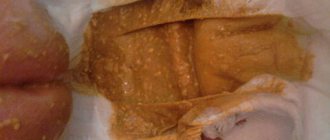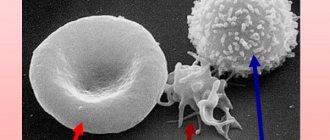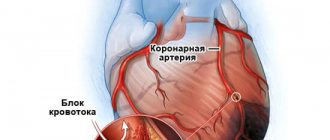» Human body » Child
In the first days of life, babies may experience blood in their stool. This is due to some features of the intrauterine development of the fetus itself. But in such cases, you need to carefully distinguish what exactly is such a phenomenon and be sure to consult a doctor or not. The fact is that if a newborn’s stool is black, there is nothing to worry about. In cases where bright red blood is present, then in such cases it is necessary to go to the hospital immediately.
This may be the first symptom of intestinal bleeding in an infant. The baby's intestines develop quite quickly, especially in the first months of life. During this period, it is quite possible to encounter such a situation, since this is a consequence of the improper development of some digestive organs. As a rule, at this time, a nursing mother is strictly prohibited from eating food and drinks that can cause side irritation.
- 2 What measures to take
- 3 What to pay attention to
Blood in the stool of a baby: provoking factors
Komarovsky identifies several reasons for the appearance of blood streaks in the stool of an infant:
- anal fissures – occur due to injuries to the intestines and anus as a result of obstruction and severe straining due to constipation;
- intussusception – is a severe form of intestinal obstruction, accompanied by a serious condition. It is difficult to confuse intussusception with other diseases; the baby’s stool becomes red and takes on a liquid form, the baby is constantly capricious and cries;
- allergy – when an allergen enters the body, swelling of the mucous membrane occurs. Most often, such manifestations are observed in babies who consume formula. Food allergies are especially common when cows’ and goats’ milk is introduced into a child’s diet;
- hemorrhagic diathesis – accompanied by gastrointestinal bleeding;
- ulcerative lesions - such pathologies lead to constant but minor blood loss;
- injuries on the mother's nipples - in this case, blood along with milk enters the baby's stomach. The blood comes out along with the feces, forming thin streaks.
Komarovsky notes that infection with worms can lead to the appearance of blood streaks. Associated symptoms of this phenomenon will be weight loss, anxiety in the baby, and loss of appetite.
It is necessary to conduct a rectal examination of the child and do a stool test. If the cause of blood discharge in the baby’s stool remains unclear, a hydrogen test, stool analysis for carbohydrates, sigmoidoscopy, and FGDS are prescribed.
Diagnostic methods
When diagnosing, it is necessary to follow all the doctor’s prescriptions, and also not engage in self-diagnosis and self-medication, this can complicate the situation. Determining the cause of bleeding requires the following tests:
A stool test will help determine the cause of the problem.
- checking the anus with a finger;
- collection of stool for research within the laboratory;
- specialized examination of the digestive system;
- examination of the rectum using endoscopy;
- identification of enzyme performance and digestive process;
- X-ray examination of the rectum.
Komarovsky about streaks of blood in the stool of a baby
Adequate treatment cannot be prescribed in absentia, so Komarovsky does not recommend self-medication if streaks of blood are detected in the stool of an infant. If intestinal infections are detected in an infant, antimicrobial and antibacterial therapy is prescribed.
If the appearance of blood is a consequence of a food allergy, it is necessary to identify the allergen and exclude it from the child’s diet. Blood streaks in the stool that are the result of poor nutrition of the mother or injury to her nipples should not cause concern. In this case, it is necessary to pay attention to the health of the mother and leave the baby alone.
Most often, the appearance of streaks in stool is accompanied by a change in its color and consistency. Dark, almost black stool may be associated with stomach or intestinal bleeding.
The most common cause of blood streaks in a baby's stool is trauma to the anus. Damage to the anus occurs due to intestinal obstruction. In order to improve a child’s digestion, it is necessary to choose the right diet and balance the diet.
Komarovsky advises increasing intestinal tone. For this purpose, abdominal massage and therapeutic exercises, including spreading and bending the legs, will be useful. If the child is fed breast milk, then the mother needs to reconsider the diet, introduce more water, fermented milk products, prunes and dried apricots into the diet. When bottle-feeding, it is advisable to offer the child water more often, and prepare the formula in a more liquid form than suggested by the manufacturer.
The dark color of stool, with bloody spots, makes parents really worry about the baby’s health. Sometimes there really is a reason to visit a doctor; you cannot postpone treatment. It is often too early to rush to conclusions, since the reasons may be completely harmless, and the baby may be completely healthy. It is necessary to figure out what causes streaks of blood in the baby's stool.
Prevention of blood from the anus in a child
So let's continue. Parents often turn to doctors in panic if the child poops and there is blood on the bottom. This condition can indeed be dangerous, but most often it is associated with poor diet and lifestyle. You should follow simple rules of prevention in order to avoid such health problems in your child:
- The diet must contain fiber - fresh vegetables, fruits, bran. To avoid constipation, you need to include beets and broccoli in your daily diet.
- Drinking enough water will ensure normal bowel movements and the absence of constipation, together with dietary adjustments.
- Carefully ensure that while playing, the baby does not put toy parts, nuts, seeds or other small and sharp objects into his mouth or respiratory tract.
- Once a quarter, conduct a blood test and ultrasound of internal organs if there is a suspicion of the development of pathologies of the gastrointestinal organs.
When you don't need to worry
The following reasons may affect the color of your stool:
- Mom's nutrition. For example, if you ate tomatoes, currants, or beets the day before, the color of the stool will change and become reddish.
- Use of medicines. If you have recently undergone treatment or are taking medications for preventive purposes, there may be changes. Such medications include all tablets with dye, antibiotics, and products containing iron.
- Introduction of complementary foods. If you are already transferring your baby to an additional type of feeding - complementary feeding, the digestive system begins to rebuild, changes occur.
Within a few days after birth, the baby's stool is just forming, so its color and consistency may change. The only cause for concern at this time is a high level of scarlet blood. In this case, you should immediately show the child to your doctor.
Treatment
In any case, the therapy should be selected by a doctor. Self-medication can aggravate the course of the disease and cause serious complications. If you have obvious symptoms, you should immediately call an ambulance and do not take any action until they arrive. Do not give your child painkillers, give an enema, or use a heating pad. Also, ice should not be applied to the stomach. You are not allowed to drink or eat until the doctor arrives.
Sources of blood in stool
Blood in a child's stool can come from two sources:
- The upper parts of the digestive system are the stomach, esophagus, duodenum. The child vomits blood, and the remaining blood goes into the stool, which is why it becomes dark, almost black.
- Lower sections - colon, anus, rectum. When bleeding begins in these organs, red or bright scarlet spots appear in the stool.
Depending on what caused the violation, appropriate treatment or specialized procedures are prescribed.
Hirschsprung's disease in a child
This is a fairly rare congenital anomaly of the colon. In babies, it manifests itself from birth with persistent constipation, flatulence, pain in the epigastric region, severe problems with feces and a “frog” stomach. With this disease, the stool in infants is very hard, often it is necessary to perform enemas, which causes injuries to the rectal mucosa and the child bleeds from the butt.
If you suspect such a rare disease, you should consult a pediatrician. Perhaps, to solve the problem, just changing your diet is enough - the stool will improve. Young parents often like to look for rare diseases in their children. Hirschsprung's disease is very rare - less than 0.5% of cases. It is impossible to diagnose it without special studies in gastroenterology.
Causes of blood in baby's stool
It is impossible to determine the cause on your own - for this, a thorough examination is carried out at a medical institution, however, parents can first find out which causes are the most common when blood appears in the stool of a breastfed child. It’s even better to engage in prevention so that such a problem does not bother you at all.
Anal fissure
It is observed in children of any age. The intestinal mucosa is injured due to prolonged constipation, too hard stool, flatulence, and gas formation. The blood is bright in color and is found directly on the surface of the stool, on toilet paper (wet napkin). In addition to blood, the child may experience pain, groaning, and a painful facial expression. Going to the toilet is accompanied by discomfort, sometimes children scream in pain.
To prevent the problem, it is necessary to monitor the diet of mother and child to prevent the appearance of hard feces. The right diet, ointments, enemas, medications - all these means will help avoid the disease.
The quality of a nursing mother's diet directly affects the digestion and condition of the baby's gastrointestinal tract. Avoid foods that form hard stool
Allergy to protein
The problem is typical for children on artificial or mixed feeding. The body reacts negatively to milk or soy protein, as well as to other products. The mucous membrane becomes inflamed, and a little blood appears in the discharge. If your child has allergies, you should show them to your pediatrician. A special gentle mixture is prescribed for him, as well as a diet for the mother.
Intussusception
The disease occurs very often between the ages of 4 months and a year, and it requires immediate medical attention. The problem is caused by poor nutrition and begins acutely, with sharp pain in the tummy. Then vomiting appears, the episodes are repeated, the child cries, cannot sleep, exacerbations occur in paroxysms. The stool in this case is called “raspberry jelly” because of its liquid consistency, as well as the mixture of mucus and blood in it. Upon palpation, a solid formation is detected in the abdominal cavity. If the baby is immediately taken to the hospital, there is a chance of avoiding surgical intervention.
Inflammatory bowel diseases
These include ulcerative colitis and Crohn's disease. In addition to blood, diarrhea, loss of appetite, fever, and abdominal pain are noted. At the initial stages, only veins are visible, when the disease is severe, significant impurities are visible.
Only a doctor can prescribe treatment; the main thing is to contact him in time to avoid problems in the future. Getting rid of the disease is quite difficult - sometimes it takes several years.
Intestinal infections
This could be salmonellosis, botulism, dysentery, or typhoid fever. The symptom is frequent and loose stools with mushy impurities, sometimes mucus appears in it. There is also vomiting, nausea, fever, and the child’s general condition is depressed (see also: vomiting after feeding in a newborn). Salmonellosis also occurs with bloody diarrhea. You must immediately call a doctor - lack of proper treatment can lead to death.
Juvenile polyps
The disease causes constant bleeding and streaks of blood in the child's stool. Symptoms include hard stools, regular constipation, and going to the toilet is a challenge for the baby. Most often occurs between the ages of 2 and 8 years. There is only one treatment for the disease - through surgery. Prevention includes proper nutrition and an active lifestyle.
Helminthiasis
It would seem that it is impossible to get infected while breastfeeding, but during the first five years the problem is very common. May be accompanied by anal itching, anxiety, and diarrhea. The symptoms worsen especially strongly after eating, the child loses appetite and complains of abdominal pain in the morning.
Blood in a newborn's stool is not always visible to the naked eye, so an occult blood test is required. A positive result indicates gastritis, ulcers, duodenitis.
What should parents do?
The famous doctor Komarovsky does not advise treating the disease at home. Bloody discharge in a baby is a reason to visit a pediatrician, even if no other symptoms are noted. The sooner you contact a medical facility, the better.
The most dangerous thing is the appearance of additional symptoms: fever, anxiety, lethargy, nausea. In this situation, you need to call an ambulance; you cannot give water or food to the child, nor should you give him medications. It is better to save the feces of a newborn and show it to the doctor - this will facilitate diagnosis. As a last resort, take a photo.
In any case, you will have to take several tests and undergo an examination, including:
- palpation of the abdomen and anal area;
- probe or FEGDS;
- coprogram;
- colonoscopy;
- sigmoidoscopy;
- bacterioscopic analysis.
So that diseases do not bother you, and your baby always remains healthy, take preventive measures. It is especially important to do this in the first years of life, because the younger the child, the more difficult it is for him to survive even the simplest illness. Later, teach your baby to wash his hands with soap to avoid intestinal infections. Believe me, this habit will be useful to him in adult life. If salmonellosis is detected in one of the family members, children must be isolated for preventive purposes.
According to Dr. Komarovsky, the most common diseases in the first year of life are colds and digestive problems . And if frequent colds are, as a rule, the fault of parents who try to feed and warm them, then it is not clear what is the reason for frequent digestive disorders and intestinal problems in general?
The fact is that a baby is born with a digestive system, which at the beginning of its journey is actively populated by microflora and adapts to new food. This condition is often accompanied by changes in the infant's stool. Therefore, the contents of the diaper are subject to careful inspection by many parents. During such an examination, young mothers often find blood in their stool.
This fact cannot but cause concern. Blood in a baby's stool may look like clots, or be in the form of streaks or inclusions. Komarovsky claims that regardless of the reasons, this is a reason to see a doctor.
Prevention measures
- Breast milk is the best food. Feed your baby exclusively breast milk for the first six months. Breast milk is best for the baby's gastrointestinal tract and carries antibodies that keep infections at bay. This improves the efficiency of the child's immune system.
- Periodically check your child's anus for cracks or inflammation. If you find something suspicious and feel it deserves medical attention, don't hesitate to take your child to the doctor.
- Be careful about allergies. When a doctor diagnoses an allergy, make sure that the child does not come into contact with the source of the adverse condition. Monitor your child after consuming any possible allergen product. Food allergies can be controlled with diet and antihistamines prescribed by your doctor.
Any parent who has ever witnessed blood in the stool of their newborn or older child instantly feels fear. The causes of this condition in a baby can be both simple and serious: from an allergic reaction to an infection. But, in any case, this phenomenon deserves the close attention of parents and, in the presence of other suspicious symptoms, doctors.
Blood in the stool of a baby. Causes
Komarovsky names the following reasons for the appearance of blood:
1. Most often, blood in the stool in the form of small streaks or inclusions indicates that there are cracks or other damage in the child’s anus or on the walls of his rectum . Such damage usually occurs due to constipation, or due to too hard stool. Often these microcracks can be noticed during a simple inspection.
2. In addition, blood in the stool can serve as a signal of an allergy to cow's milk protein . This disease occurs in a small percentage of children, and, as a rule, does not go unnoticed. Symptoms such as dermatitis, vomiting, chronic constipation or diarrhea appear. Such allergies can be diagnosed using tests. In addition, you can conduct a simple test - a nursing mother only needs to give up dairy products (including powdered milk, which is often added to confectionery or sauces) for at least a week. If the baby’s well-being improves after this and the symptoms go away, this is a reason to undergo the necessary tests, of course, after consulting with a specialist.
3. In addition, blood in the stool can be detected if the child has contracted an intestinal infection . This condition is usually accompanied by a change in the general condition of the baby. The following symptoms appear:
· diarrhea
· vomit
increased body temperature
· stomach ache
4. The presence of parasites , for example, worms, can also cause the appearance of small spots of blood in the stool. Because parasites, penetrating into the mucous membrane, damage it.
5. Also among the reasons for the appearance of blood in the stool of a baby, Komarovsky names the presence of cracks in the mother’s nipples.
Of course, there are other reasons, but only a specialist can diagnose and treat them.
Internal bleeding in a child
This is the most dangerous condition, which very often leads to death. It does not matter for what reason it developed - internal or external trauma. It is enough that blood flows in a thin stream from the rectum - you should urgently call an ambulance. In children, death from blood loss occurs much faster than in adults.
Blood may also begin to come from the throat or come out of the mouth - this indicates an injury or crack in one of the upper intestines. This is also a reason to consult a doctor as soon as possible.











